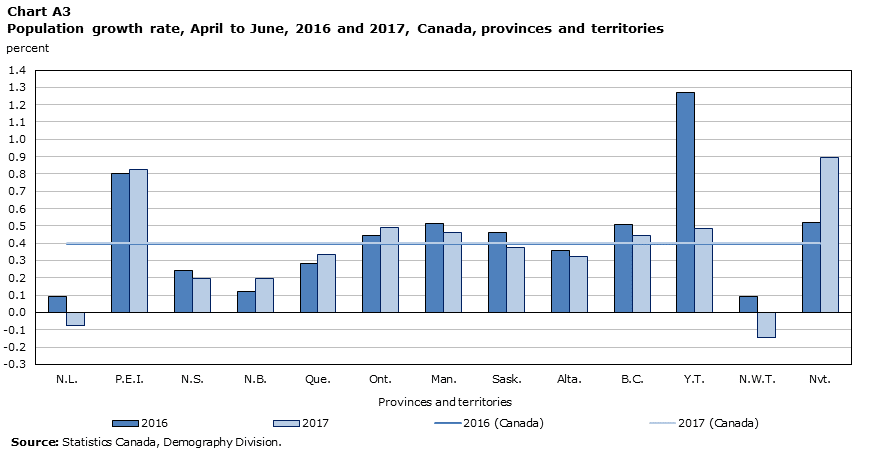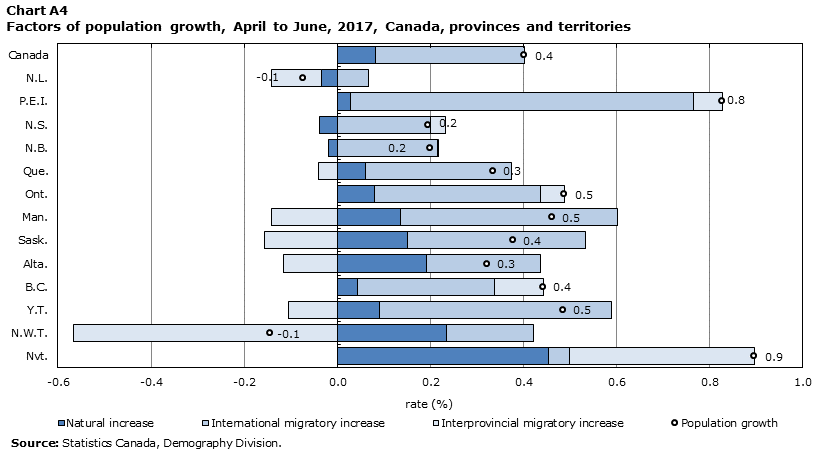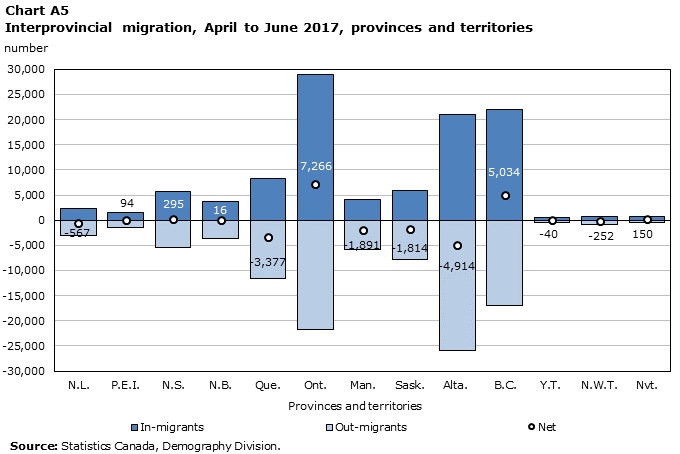Quarterly Demographic Estimates
April to June 2017
Archived Content
Information identified as archived is provided for reference, research or recordkeeping purposes. It is not subject to the Government of Canada Web Standards and has not been altered or updated since it was archived. Please "contact us" to request a format other than those available.
Highlights
- On July 1, 2017, Canada’s population was estimated at 36,708,083.
- Between April 1 and June 30, 2017, Canada’s population grew by 147,307 (+0.4%).
- Canada’s population growth in the second quarter of 2017 was mainly due to international migration (+117,380).
- Nunavut had the highest population growth rate (+0.9%) during this period, followed by Prince Edward Island (+0.8%).
- During the second quarter of 2017, interprovincial migration growth in Alberta remained negative for an eighth consecutive quarter.
Analysis
Canada’s population continues to grow at a steady pace
According to preliminary estimates, Canada’s population was estimated at 36,708,083 on July 1, 2017, up 147,307 from April 1, 2017. This population growth was higher than what is generally observed during the April-to-June period (+119,019 on average over the past 10 years). The population growth seen in the last quarter (0.4%) has not been this high since the second quarter of 1992 (0.4%), after which positive values followed a downward trend until the end of the 1990s. The 1990s were marked by a recession at the beginning of the period, and its effects were felt throughout most of the decade.Note 1

Data table for Chart A1
| Year | Percent |
|---|---|
| 1997 | 0.29 |
| 1998 | 0.25 |
| 1999 | 0.29 |
| 2000 | 0.30 |
| 2001 | 0.35 |
| 2002 | 0.33 |
| 2003 | 0.29 |
| 2004 | 0.29 |
| 2005 | 0.31 |
| 2006 | 0.31 |
| 2007 | 0.31 |
| 2008 | 0.36 |
| 2009 | 0.35 |
| 2010 | 0.34 |
| 2011 | 0.33 |
| 2012 | 0.37 |
| 2013 | 0.38 |
| 2014 | 0.34 |
| 2015 | 0.27 |
| 2016 | 0.39 |
| 2017 | 0.40 |
| Source: Statistics Canada, Demography Division. | |
International migration continues to account for most population growth
Population growth at the national level is based on two factors: natural increaseNote 2 and international migratory increase,Note 3 while provincial and territorial population estimates also factor in interprovincial migratory increase.
International migratory increase remained the main driver of population growth, with an estimated increase of 117,380 between April 1 and June 30, 2017. This is the highest increase seen in a second quarter since the beginning of the period covered by the current demographic accounting system (July 1971). The number of immigrants admitted into Canada during this period (+78,021) was one of the highest for a second quarter, surpassed only by last year’s record numbers (+88,289). At the same time, the number of non-permanent residentsNote 4 increased by 47,632 during the second quarter of 2017, an unprecedented level for a second quarter. The components of net emigration (immigration, return emigration and net temporary emigration) remained stable.
According to preliminary estimates, natural increase in the second quarter of 2017 was 29,927, or the difference between 97,411 births and 67,484 deaths.

Data table for Chart A2
| Year | Natural increase | International migratory increase | Population growth |
|---|---|---|---|
| number | |||
| 1997 | 39,842 | 50,582 | 87,936 |
| 1998 | 38,520 | 38,959 | 74,993 |
| 1999 | 35,885 | 53,191 | 86,590 |
| 2000 | 34,892 | 59,296 | 91,700 |
| 2001 | 33,316 | 78,621 | 109,600 |
| 2002 | 29,589 | 76,785 | 104,177 |
| 2003 | 30,645 | 63,316 | 91,763 |
| 2004 | 30,923 | 64,392 | 93,117 |
| 2005 | 32,255 | 71,106 | 101,164 |
| 2006 | 34,143 | 71,312 | 100,043 |
| 2007 | 36,491 | 74,853 | 102,789 |
| 2008 | 36,669 | 90,807 | 118,918 |
| 2009 | 38,482 | 86,895 | 116,821 |
| 2010 | 36,864 | 87,008 | 115,317 |
| 2011 | 36,485 | 79,307 | 112,126 |
| 2012 | 35,580 | 93,911 | 129,491 |
| 2013 | 34,657 | 98,213 | 132,870 |
| 2014 | 33,887 | 87,388 | 121,275 |
| 2015 | 32,219 | 66,138 | 98,357 |
| 2016 | 31,704 | 110,521 | 142,225 |
| 2017 | 29,927 | 117,380 | 147,307 |
|
Note: Before 2012, population growth is not equal to the sum of natural increase and international migratory increase because residual deviation must also be considered in the calculation. Source: Statistics Canada, Demography Division. |
|||
The population grew everywhere except in Newfoundland and Labrador and the Northwest Territories
During the second quarter of 2017, population growth was positive in all provinces and territories, except Newfoundland and Labrador and the Northwest Territories.Note 5 Nunavut (+0.9%) had the highest rate of population growth in Canada, followed by Prince Edward Island (+0.8%). The population growth rate in Ontario, Manitoba and Yukon (+0.5%) was stronger than the rate for Canada (+0.4%).
Compared with the same period last year, the population growth rates for most provinces remained stable during the second quarter of 2017. Newfoundland and Labrador posted a 0.2 percentage points decrease between the two quarters. The territories were also an exception, with decreases of 0.2 and 0.8 percentage points in the Northwest Territories and Yukon respectively. Meanwhile, population growth in Nunavut rose 0.4 percentage points compared with the second quarter of 2016.
Data table for Chart A3
| Provinces and territories | 2016 | 2017 |
|---|---|---|
| percent | ||
| CanadaPopulation growth Note 1 | 0.4 | 0.4 |
| N.L. | 0.1 | -0.1 |
| P.E.I. | 0.8 | 0.8 |
| N.S. | 0.2 | 0.2 |
| N.B. | 0.1 | 0.2 |
| Que. | 0.3 | 0.3 |
| Ont. | 0.4 | 0.5 |
| Man. | 0.5 | 0.5 |
| Sask. | 0.5 | 0.4 |
| Alta. | 0.4 | 0.3 |
| B.C. | 0.5 | 0.4 |
| Y.T. | 1.3 | 0.5 |
| N.W.T. | 0.1 | -0.1 |
| Nvt. | 0.5 | 0.9 |
|
||
International migration is the main driver of growth in almost all provinces
During the second quarter of 2017, international migratory increase was the main driver of population growth in almost all the provinces and in Yukon. However, in Alberta, international migratory increase and natural increase contributed equally to that province’s growth. The same was true in the Northwest Territories, except that there was no population growth in the territory due to a net population loss of individuals to other provinces and Yukon, offsetting the gains from international migratory increase and natural increase. Moreover, growth in Nunavut was explained by both natural increase (+0.5%) and interprovincial migratory increase (+0.4%).
Compared with the same quarter last year, international migratory rose in Quebec, Ontario, British Columbia, Yukon and the Northwest Territories (not shown). This was primarily attributable to an increase in the number of non-permanent residents compared with the second quarter of 2016. For example, Ontario posted an increase of 26,017 in non-permanent residents, compared with 16,618 the same quarter one year earlier. Meanwhile, Quebec posted a net gain of 11,963 non-permanent residents, up from the second quarter of 2016 (+8,521). In British Columbia, the number of non-permanent residents rose 6,253, more than double the increase recorded during the same quarter last year (+2,751).

Data table for Chart A4
| Provinces and territories | Natural increase | International migratory increase | Interprovincial migratory increase | Population growth |
|---|---|---|---|---|
| rate (%) | ||||
| Canada | 0.08 | 0.32 | 0.00 | 0.40 |
| N.L. | -0.03 | 0.07 | -0.11 | -0.07 |
| P.E.I. | 0.03 | 0.74 | 0.06 | 0.83 |
| N.S. | -0.04 | 0.20 | 0.03 | 0.19 |
| N.B. | -0.02 | 0.22 | 0.00 | 0.20 |
| Que. | 0.06 | 0.31 | -0.04 | 0.33 |
| Ont. | 0.08 | 0.36 | 0.05 | 0.49 |
| Man. | 0.14 | 0.47 | -0.14 | 0.46 |
| Sask. | 0.15 | 0.38 | -0.16 | 0.38 |
| Alta. | 0.19 | 0.24 | -0.11 | 0.32 |
| B.C. | 0.04 | 0.29 | 0.10 | 0.44 |
| Y.T. | 0.09 | 0.50 | -0.10 | 0.48 |
| N.W.T. | 0.24 | 0.19 | -0.57 | -0.14 |
| Nvt. | 0.45 | 0.04 | 0.40 | 0.90 |
| Source: Statistics Canada, Demography Division. | ||||
| Population | Population growth for the second quarter | ||||
|---|---|---|---|---|---|
| 2016 | 2017 | ||||
| number | rate (%) | number | rate (%) | ||
| Canada | 36,708,083 | 142,225 | 0.4 | 147,307 | 0.4 |
| N.L. | 528,817 | 477 | 0.1 | -387 | -0.1 |
| P.E.I. | 152,021 | 1,193 | 0.8 | 1,252 | 0.8 |
| N.S. | 953,869 | 2,298 | 0.2 | 1,853 | 0.2 |
| N.B. | 759,655 | 904 | 0.1 | 1,507 | 0.2 |
| Que. | 8,394,034 | 23,699 | 0.3 | 28,012 | 0.3 |
| Ont. | 14,193,384 | 61,709 | 0.4 | 69,079 | 0.5 |
| Man. | 1,338,109 | 6,764 | 0.5 | 6,149 | 0.5 |
| Sask. | 1,163,925 | 5,277 | 0.5 | 4,376 | 0.4 |
| Alta. | 4,286,134 | 15,065 | 0.4 | 13,736 | 0.3 |
| B.C. | 4,817,160 | 24,126 | 0.5 | 21,269 | 0.4 |
| Y.T. | 38,459 | 480 | 1.3 | 186 | 0.5 |
| N.W.T. | 44,520 | 41 | 0.1 | -64 | -0.1 |
| Nvt. | 37,996 | 192 | 0.5 | 339 | 0.9 |
| Source: Statistics Canada, Demography Division. | |||||
Alberta posted an interprovincial migratory decrease (-4,914) for an eighth straight quarter (not shown). Alberta has not seen this many consecutive quarters with negative results since the second half of the 1980s, when the province saw 10 consecutive quarters of interprovincial migration losses. Alberta’s migratory losses primarily benefitted British Columbia and Ontario. The same was true for Saskatchewan (-1,814), with significant departures for British Columbia and Ontario, followed by Alberta. The scenario in Manitoba was similar (-1,891). Ontario (+7,266) and British Columbia (+5,034) continued to post the strongest interprovincial migratory increases in numbers. Nova Scotia (+295), Nunavut (+150), Prince Edward Island (+94) and New Brunswick (+16) also had positive, but more moderate, interprovincial migratory increases. In Quebec, interprovincial migration remained negative (-3,377). The last time Quebec had net interprovincial migration above zero was in the fourth quarter of 2009 (+15).

Data table for Chart A5
| Provinces and territories | In-migrants | Out-migrants | Net |
|---|---|---|---|
| number | |||
| N.L. | 2,409 | -2,976 | -567 |
| P.E.I. | 1,485 | -1,391 | 94 |
| N.S. | 5,723 | -5,428 | 295 |
| N.B. | 3,741 | -3,725 | 16 |
| Que. | 8,268 | -11,645 | -3,377 |
| Ont. | 29,045 | -21,779 | 7,266 |
| Man. | 4,015 | -5,906 | -1,891 |
| Sask. | 5,909 | -7,723 | -1,814 |
| Alta. | 20,945 | -25,859 | -4,914 |
| B.C. | 22,076 | -17,042 | 5,034 |
| Y.T. | 522 | -562 | -40 |
| N.W.T. | 706 | -958 | -252 |
| Nvt. | 674 | -524 | 150 |
| Source: Statistics Canada, Demography Division. | |||
- Date modified:

